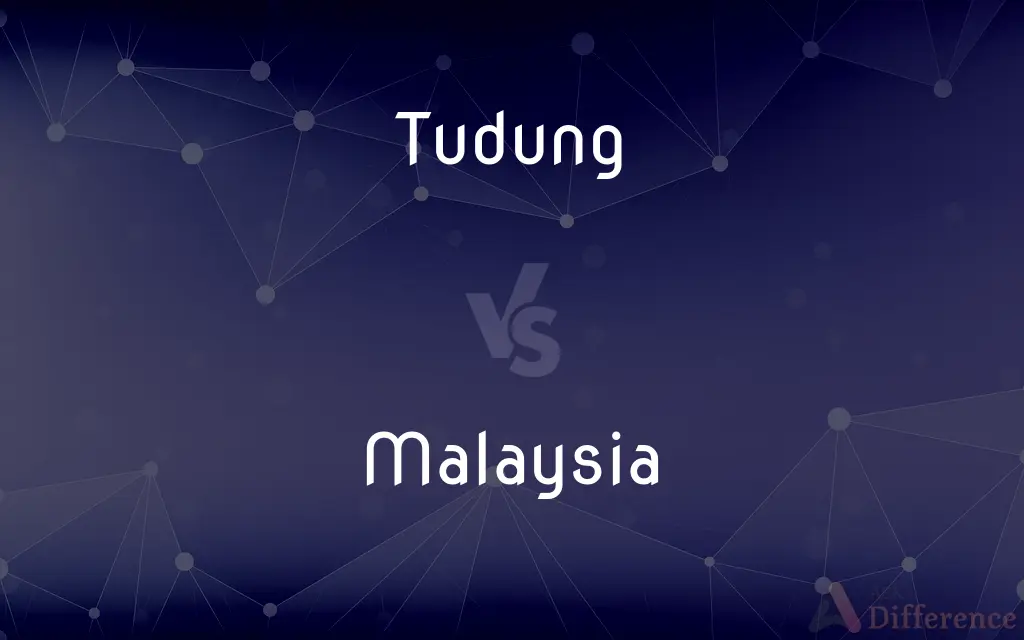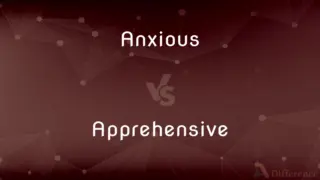Tudung vs. Malaysia — What's the Difference?
By Maham Liaqat & Urooj Arif — Updated on April 17, 2024
Tudung is a type of headscarf worn by Muslim women, particularly in Malaysia, to cover the head and neck, while Malaysia is a country in Southeast Asia known for its cultural diversity, including its predominantly Muslim population.

Difference Between Tudung and Malaysia
Table of Contents
ADVERTISEMENT
Key Differences
Tudung, commonly referred to as a hijab in other parts of the Muslim world, is an essential piece of clothing for many Muslim women in Malaysia, symbolizing modesty and religious observance. Whereas, Malaysia is a country that encompasses more than just the Muslim community, featuring a tapestry of ethnic groups including Malay, Chinese, Indian, and indigenous peoples.
While the tudung is worn as part of everyday attire by many Malaysian Muslim women, reflecting their religious beliefs and cultural practices, Malaysia’s national identity is broader, encompassing a range of customs, languages, and religions. The country is not defined solely by the Islamic faith, though Islam is the official religion.
The tudung in Malaysia is also a symbol of cultural identity and can vary in style, fabric, and color, reflecting regional differences and personal preferences within the country. On the other hand, Malaysia's diverse geography from bustling cities like Kuala Lumpur to natural landscapes like Borneo’s rainforests showcases the country's physical and cultural variety.
In terms of legal and social norms, wearing the tudung in Malaysia is widely accepted and in some cases expected in certain settings to conform to Islamic modesty standards. In contrast, Malaysia as a nation has laws and regulations that accommodate a wide range of cultural practices and religious observances beyond just Islamic traditions.
The importance of the tudung in Malaysian society reflects the country’s commitment to preserving its Islamic heritage, while simultaneously, Malaysia’s global and multicultural stance is evident in its economic, diplomatic, and social interactions on the international stage.
ADVERTISEMENT
Comparison Chart
Definition
A headscarf worn by Muslim women
A Southeast Asian country
Cultural Significance
Symbolizes modesty and piety
Represents cultural diversity
Usage
Personal attire
Geopolitical entity
Variability
Styles and fabric differ
Diverse landscapes and cultures
National Context
Part of Islamic practice
Multicultural nation with official Islam religion
Compare with Definitions
Tudung
Seen as a symbol of modesty and piety within the Islamic community.
Wearing a tudung is part of her daily routine to reflect her religious beliefs.
Malaysia
Features a range of natural environments from beaches to rainforests.
The diverse ecosystems of Malaysia attract tourists from around the world.
Tudung
Often used to express both religious adherence and personal style.
Her collection of tudungs includes various fabrics like silk and cotton.
Malaysia
Promotes a multicultural society with various languages, religions, and traditions.
In Malaysia, you can hear conversations in Malay, Mandarin, Tamil, and English.
Tudung
A headscarf worn by Muslim women in Malaysia to cover their head and neck.
She chose a brightly colored tudung for the celebration.
Malaysia
Known for its significant Muslim population and as a hub of Islamic culture.
Malaysia hosts international Islamic conferences and cultural festivals.
Tudung
Integral to the identity of many Muslim women in Malaysia.
The tudung is more than an accessory; it's a key part of her identity.
Malaysia
A country located in Southeast Asia known for its cultural, religious, and ethnic diversity.
Malaysia is celebrated for its vibrant mix of Malay, Chinese, and Indian cultures.
Tudung
Can vary widely in style depending on the occasion and individual preference.
For formal events, she wears a tudung made from luxurious materials.
Malaysia
Has a dynamic economy that includes tourism, manufacturing, and technology.
Malaysia’s economy benefits from its strategic location along major sea routes.
Tudung
A form of the hijab worn in Malaysia
Malaysia
Malaysia ( (listen) mə-LAY-zee-ə, -zhə; Malay: [məlejsiə]) is a country in Southeast Asia. The federal constitutional monarchy consists of thirteen states and three federal territories, separated by the South China Sea into two regions, Peninsular Malaysia and Borneo's East Malaysia.
Tudung
A scarf worn around the head by Muslim women in Malaysia; conceals the hair but not the face
Malaysia
A country in Southeast Asia including the former nation of Malaya on the Malay Peninsula, and part of Borneo; sometimes still referred to as Malaya.
Malaysia
A constitutional monarchy in southeastern Asia on Borneo and the Malay Peninsula; achieved independence from the United Kingdom in 1957
Common Curiosities
Can non-Muslims wear a tudung in Malaysia?
Non-Muslims can wear a tudung, especially when participating in certain cultural or religious events as a sign of respect, though it is not a common practice for them.
How do the styles of tudung vary across different regions in Malaysia?
The styles of tudung can vary widely, with differences in color, fabric, and design reflecting regional tastes and the influences of local cultures. For instance, urban areas might favor more modern, fashionable styles while rural regions might adhere to traditional patterns and fabrics.
What are the main economic sectors in Malaysia?
Malaysia's economy is diversified across various sectors including electronics manufacturing, palm oil production, petroleum and natural gas extraction, tourism, and finance, contributing to its status as one of the stronger economies in Southeast Asia.
Why is the tudung significant in Malaysian culture?
The tudung is significant as it represents the religious and cultural values of modesty and piety prevalent among many Muslim women in Malaysia.
How is the tudung viewed in the professional setting in Malaysia?
In professional settings in Malaysia, wearing a tudung is common and widely accepted. Many corporate dress codes respect religious attire, and in governmental or educational institutions, the tudung is often part of the official uniform for Muslim women.
What makes Malaysia unique in Southeast Asia?
Malaysia's unique blend of ethnicities, cultures, and religions, alongside its rich natural biodiversity, distinguishes it within Southeast Asia.
How does Malaysia handle its cultural diversity?
Malaysia generally promotes a policy of multiculturalism, recognizing and celebrating the various cultural, religious, and ethnic groups within the country.
Is wearing a tudung mandatory in Malaysia?
Wearing a tudung is not legally mandatory across Malaysia, but it is a common practice in many Muslim communities and expected in certain social and religious settings.
How does Malaysia’s geography influence its culture?
Malaysia's geography, characterized by both peninsular and insular components (Peninsular Malaysia and East Malaysia), fosters diverse cultural expressions. This geographical split influences cultural practices, cuisines, and even languages, with coastal communities often involved in fishing while inland communities may focus more on agriculture or forestry.
What legal protections exist for religious practices in Malaysia?
Malaysia's constitution guarantees freedom of religion but also establishes Islam as the religion of the Federation. This dual approach leads to a complex legal environment where Islamic practices are supported and protected, while other religious communities are also allowed to practice their beliefs openly and build places of worship.
Share Your Discovery

Previous Comparison
Anxious vs. Apprehensive
Next Comparison
Anything vs. AnythinkAuthor Spotlight
Written by
Maham LiaqatCo-written by
Urooj ArifUrooj is a skilled content writer at Ask Difference, known for her exceptional ability to simplify complex topics into engaging and informative content. With a passion for research and a flair for clear, concise writing, she consistently delivers articles that resonate with our diverse audience.














































